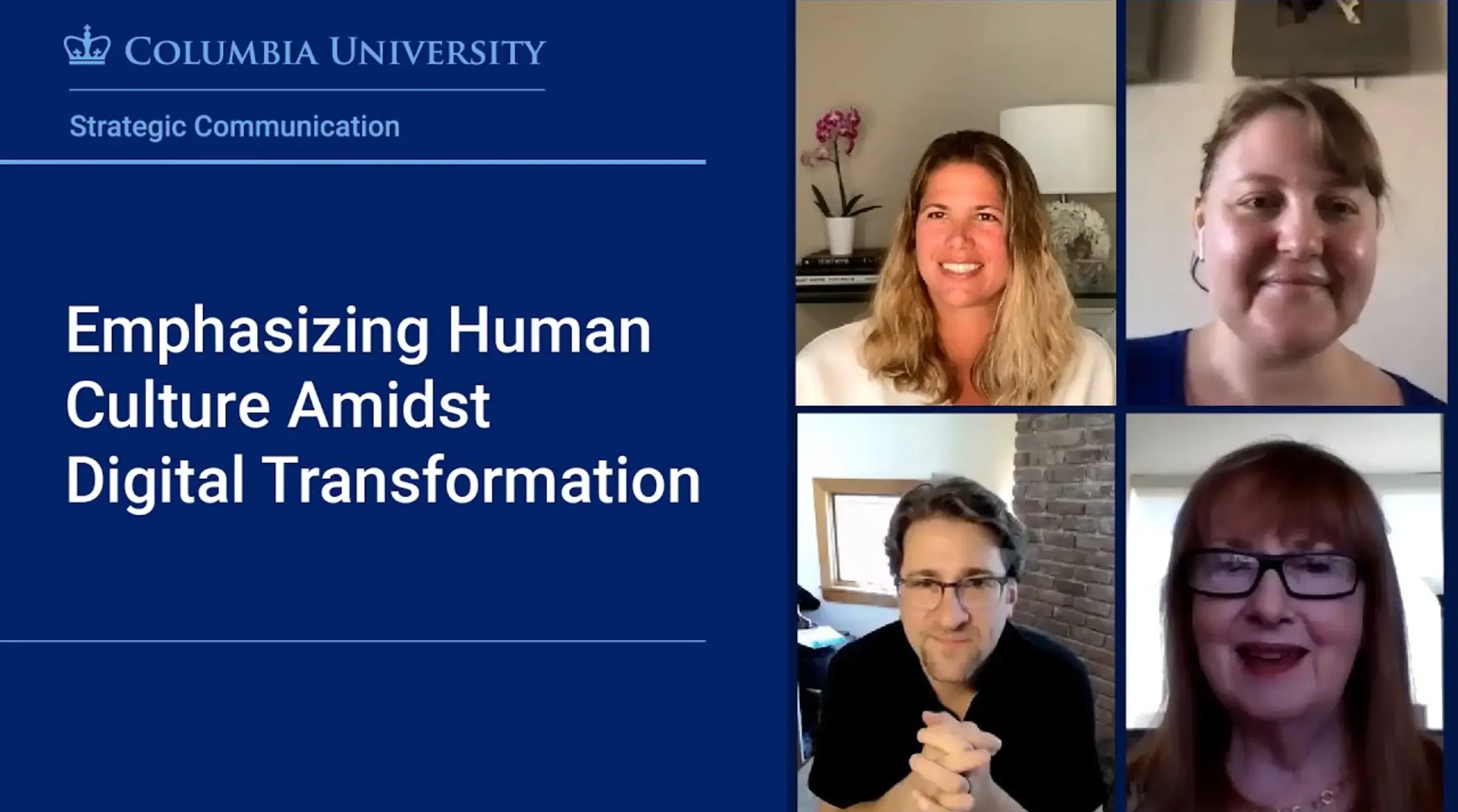The Strategic Communication program recently presented a webinar with Lecturer and Integral CEO Ethan McCarty, Communications Consultant Tiffin Jernstedt, and Afterburner Communications & Enablement Lead at IBM Performance Marketing Yana Krasnitskaya.
In our professional lives, we constantly confront tradeoffs between apparent “nice to haves” and “need to haves.” For example, it’s nice to have a kitchen with gluten free snacks in the office, but we need a functioning monitor and keyboard to perform our job.
As more companies undertake digital transformations, whether for purposes of agility and efficiency, or by necessity as a result of the pandemic, workplace culture is often miscategorized as a ‘nice to have.’
Meanwhile, a healthy culture is more important than ever to employees struggling to accommodate the volume and pace of change (especially in remote work environments.)
Integral convened two of the brightest minds with experience in digital transformation and communications to discuss the rituals, priorities and behaviors changes that leaders can implement to ensure all employers foster a positive culture and community amidst digital transformation.
In an environment as dynamic as the present, culture is the new “need to have.”
Below are some of our favorite takeaways and quotes from our two panelists, Tiffin Jernstedt, Communications Consultant, and Yana Krasnitskaya, Afterburner Communications & Enablement Lead, IBM Performance Marketing, and our CEO Ethan McCarty, from our recent webinar with the Strategic Communication program at SPS.
- Listen to your employees the same way you listen to your clients. “Whenever people want to share information internally I ask, ‘Well who is your audience?’ Because if you’re not listening to what they want and how they prefer to consume information, it’s like putting information out into the intranet and no one listening. Like the metaphor of the tree falling and no one being around to listen,” said Yana about the listening/focus groups her IBM communications team has implemented for Project Afterburner. "It’s not about the tools, it’s about empowering your clients, your audience and your employees to be prepared in advance leading up to the change… everyone consumes information differently, you have Marketers at IBM doing different jobs with different business goals, not everyone needs to hear the same CTA (Call to Action). They need to hear pieces of it that apply to them specifically.”
- With new platforms comes new responsibilities. “With a new mobile app, we were able to do an employee advocacy program [for PVH], but part of the challenge was teaching employees how to use it. You have people of all different ages and backgrounds. Everyone has a learning curve,” said Tiffin about onboarding droves of employees across many brands into one employee userface. “We were able to do an amazing employee advocacy program ... to get the message out there about who we are as a company and how all of our brands come together to drive fashion forward.”
- Transformations and culture change require leaders committed to the cause. “One of the reasons the Adobe transformation has been so successful is that we have a lot of strong leaders who are willing to put themselves in the thick of it. They come on our podcasts, they write blogs with us, and they come to town halls and discuss why the transformation is important and why people should pay attention, “ said Yana. "To me, culture needs a voice or a few voices to rally behind. It’s worked because we’ve evolved with the times. For Tiffin, it was the mobile app, for us it’s been the ongoing drumbeat. We set that up with a strong communication plan that Integral worked with us on, but it was really important for us to commit and say, ‘Once a week, we’re going to put our voice out there, experiment, and if we fail, we fail,’ but it’s worked out really well so far.”
- Internal communications teams should take a page from the PR playbook. “You have to constantly check in with your employees -- no different than your check in with your customers. My journey was going from true public relations where my focus was to engage the press to tell a brand story, to now learning HR and how powerful the employee voice is. The employee culture from a brand perspective is a huge part of your overall messaging,“ said Tiffin. “A lot of companies still are so focused on press, that they’re not taking into consideration that they’re sitting on a huge opportunity to engage and highlight their own people which only reinforces what the overall mission for that company is.”
Watch the webinar in full below.
The views expressed are those of the author and do not necessarily represent the views of any other person or entity.

